Employee monitoring is the process of tracking team members’ attendance and activity while they’re on the clock.
Whether you oversee a remote, hybrid, or field team, you need a reliable system to gather data, such as:
- When your team clocks in and out and if they worked shifts as scheduled
- Which projects and tasks they worked on throughout the day
- How much time they spent on work, and how many minutes they wasted
Monitoring teams manually requires a lot of time and oversight. However, with the right employee tracking tools, you can measure team performance automatically so everyone works more efficiently.
In this guide, we cover key types of activity monitoring and share tips for successfully implementing a solution—so you can get your team on board and immediately improve productivity.

Table of Contents
- Why companies choose to monitor their employees
- Types of employee monitoring
- Things to consider as you decide if/how you want to monitor your employees
- 3 key factors for successfully implementing employee monitoring in your company
- Curious to see how employee monitoring (the right way) can help your team be more productive?
Why companies choose to monitor their employees
Is employee monitoring the right choice for your organization? Here are some of the most significant advantages of employee monitoring tools.
Increased productivity
Do you suspect some of your team members spend less time on work-related tasks and more time on non-work activities?
An employee monitoring system can automatically log active and idle time throughout the workday. Most tracking tools can also pinpoint whether team members spend time on sites, apps, and other activities you’ve labeled unproductive.
With this data, you can identify who’s actively working on assigned tasks while on the clock—and who tends to take unscheduled or unapproved breaks. Then you can work with employees to address their behavior and improve their focus.
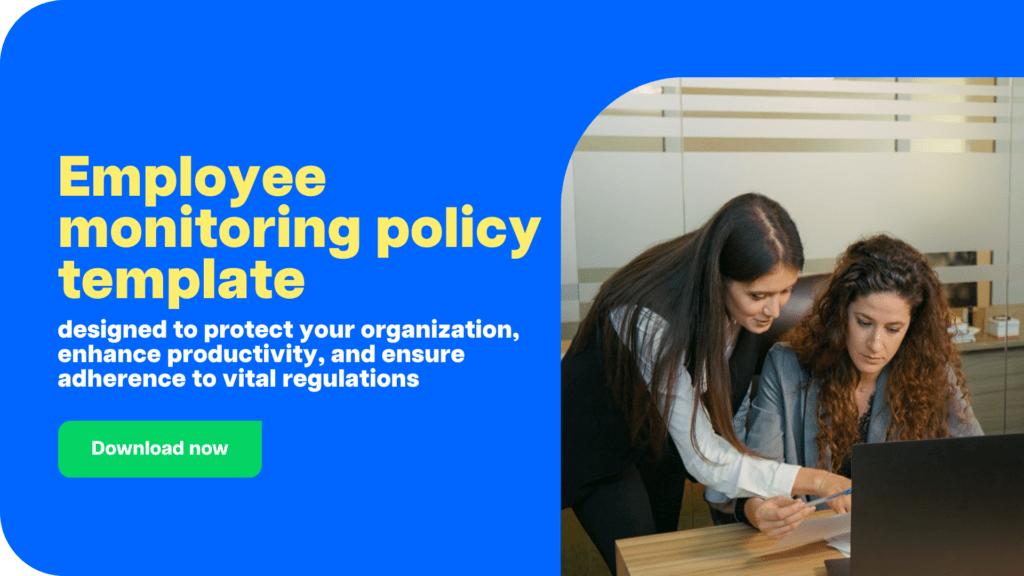
Improved employee engagement
Have you noticed the quiet quitting trend affecting your team? You aren’t alone. A recent Gallup study shows that employee engagement has been declining since 2020, and it can substantially impact fully remote teams.
The study reveals that as of 2022, only 32% of full- and part-time employees are engaged at work. Additionally, nearly 20% of employees are actively disengaged, negatively impacting morale.
Although not designed to resolve engagement issues, monitoring solutions can detect disengaged employees through attendance, productivity, and work-life balance data.
The earlier you detect signs of disengagement or trends in the wrong direction, the sooner you can address them and work to build an engaged team that’s happy to be on board.
Streamlined project planning
It’s easy enough to check your project management tool to see how many team members you’ve assigned to each project. But are you balancing responsibilities effectively? Do some employees have time to take on more tasks?
With employee tracking software, you can stop wondering if you’ve effectively planned projects or allocated resources. These tools show you exactly how many hours each team member spends on each task or project, taking the guesswork out of planning.
You can use this data to invoice clients for work done or to forecast future project budgets and timelines. You can also use this information to ensure that employees maximize their scheduled time and always have the right balance of tasks.
Higher revenue
Before investing in a new tool, you should know how it will impact your bottom line. With the right employee monitoring software, your team has the potential to recover substantial lost revenue.
Employee productivity and engagement issues can get expensive, and they might be costing your company more than you think. According to a 2022 Gallup report, disengaged employees cost employers nearly $8 trillion in lost productivity.
By using tracking software to identify productivity issues, engage employees more effectively, and plan projects more efficiently, your organization can expect to reduce losses and ultimately drive more revenue.
Types of employee monitoring
Curious what options are available for tracking teams? Here is the best employee monitoring software for every scenario, whether your team works from home, in the office, or in the field.
Computer and internet
Do you wonder whether your staff actually works during scheduled hours or spends time on personal projects instead? A recent Forbes study reveals that the average employee wastes 9 hours of work time every week, which suggests that your team likely has a lot of room for improvement.

With computer and internet monitoring, you can track the following:
- When your team logs in and out for the day so you can make sure they’re reporting for scheduled shifts
- Which websites and apps they’re using while on the clock so you can make sure they’re focusing on work tasks
- What your team is doing in real-time with a mix of screenshots and task tracking
Time Doctor tracks employees’ computer and internet usage, providing a complete list of URLs visited and time spent on each site or app. Since the platform lets you label sites and apps as productive or unproductive, you can gain insight into who’s working most efficiently. Then, you can reward top-performing teams and get less productive employees back on track.
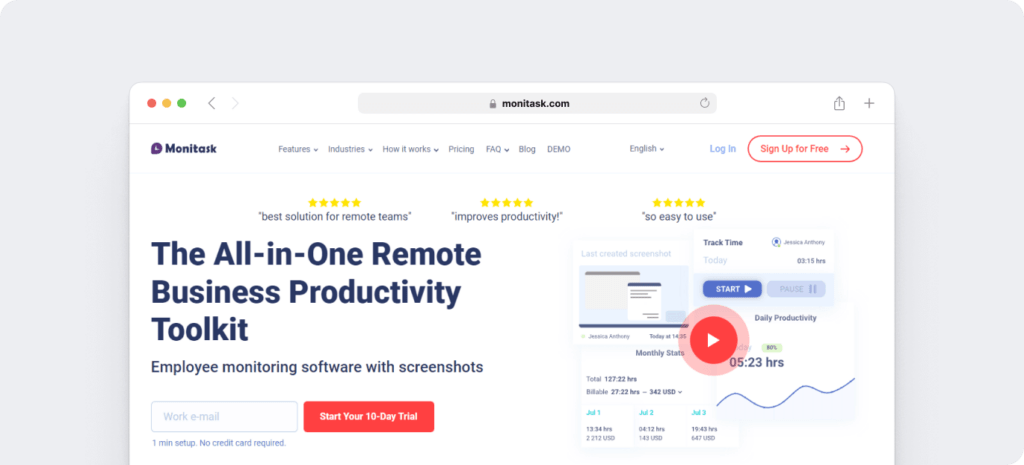
Monitask provides computer software monitoring for teams, tracking everything from activity levels to websites visited. The dashboard records internet usage and provides proof of work for remote teams.
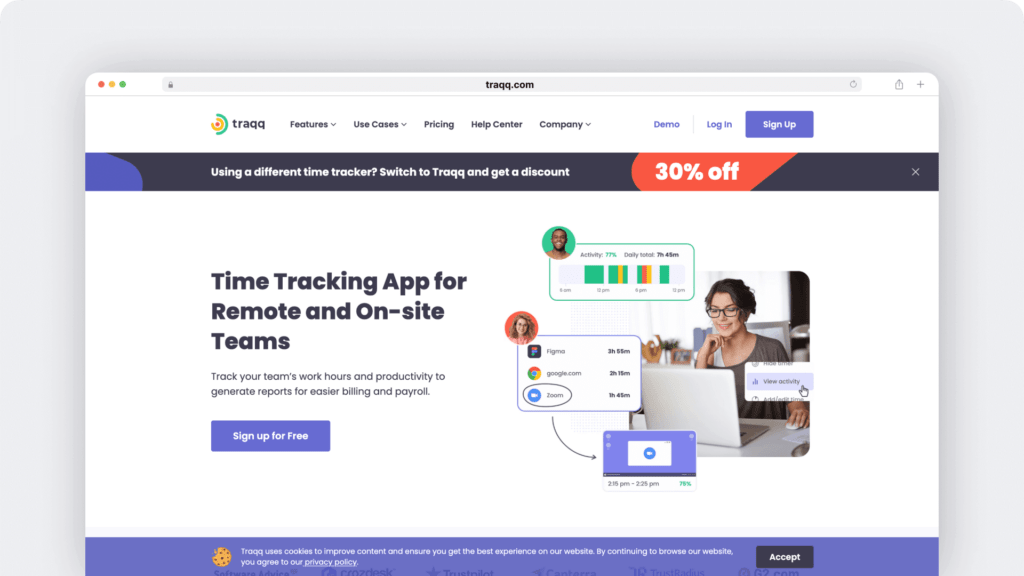
Traqq tracks the apps your team uses and the URLs they visit while working to ensure employees are being productive. This tool also uses screenshots and video recordings to monitor employee activity.
Email and communication
Tools that monitor employee emails and communications are great for companies that need enhanced security and data loss prevention. These platforms offer several features, including:
- Keystroke logging to track the information that employees share via email or chat
- Alerts notifying you if employees share private information with unapproved parties
- Blocks preventing emails from being sent if they contain specific keywords or files
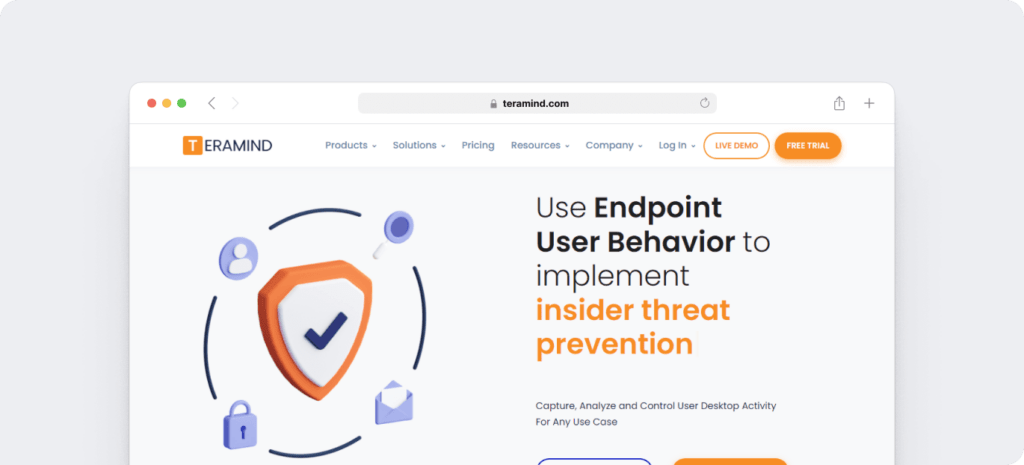
Teramind monitors both incoming and outgoing emails. The platform uses keylogging and keyword blocking to prevent security issues and protect sensitive data.
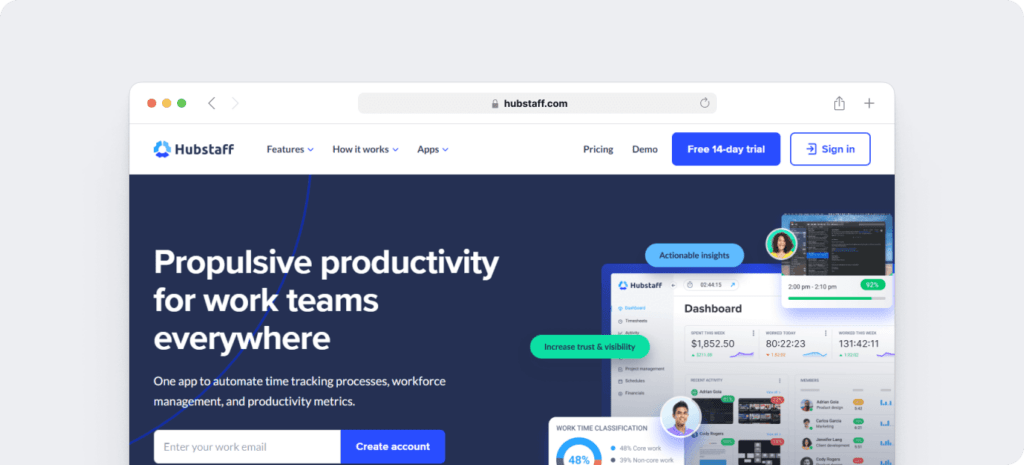
Hubstaff monitors employee email to evaluate workloads and improve communication. The platform tracks how much time team members spend on email on desktops and mobile devices.
Video
Video monitoring tools are best for employers who need detailed records of employee work hours or visual proof of user activity on work devices. These tools offer a variety of features, including:
- Screen recordings that create evidence of employee activity and offer on-demand playback
- Microphone and webcam recordings that monitor your workforce throughout their shifts
- Facial recognition features that can detect which remote employees are working at a given time
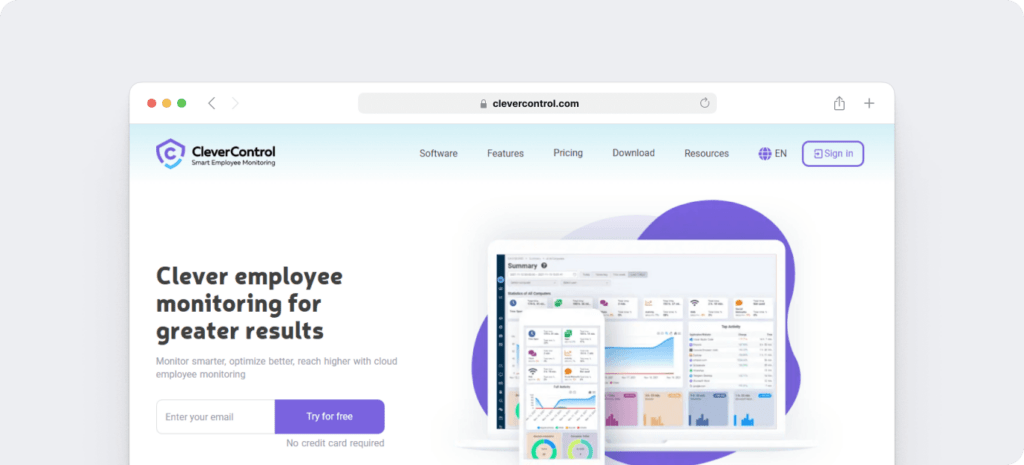
CleverControl uses both cameras and microphones to record employee activities during work. The tool also uses facial recognition to confirm who accesses laptops and desktops.
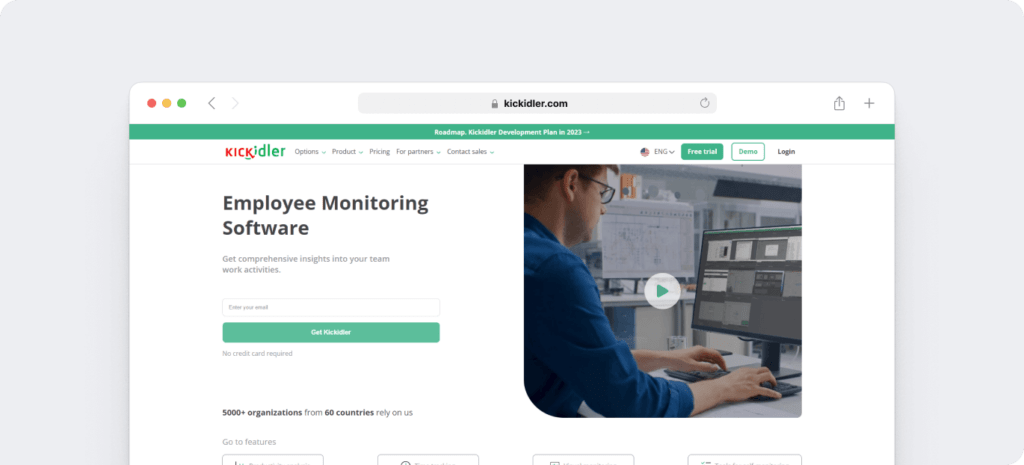
Kickidler uses screen recording technology to track productivity throughout scheduled shifts. It provides ongoing video monitoring to track application usage and spot inefficient work.
Location tracking
For field teams, location-tracking apps are ideal. They can monitor team members’ location and employees’ activity while on the clock, including when they punch in and out. Location tracking tools offer several features:
- GPS tracking, which can confirm whether employees are actually at a job site
- Geofencing, which automatically clocks employees in and out when they enter or exit a preset radius
- Facial recognition or fingerprint scanning, which can prevent colleagues from punching in and out for each other
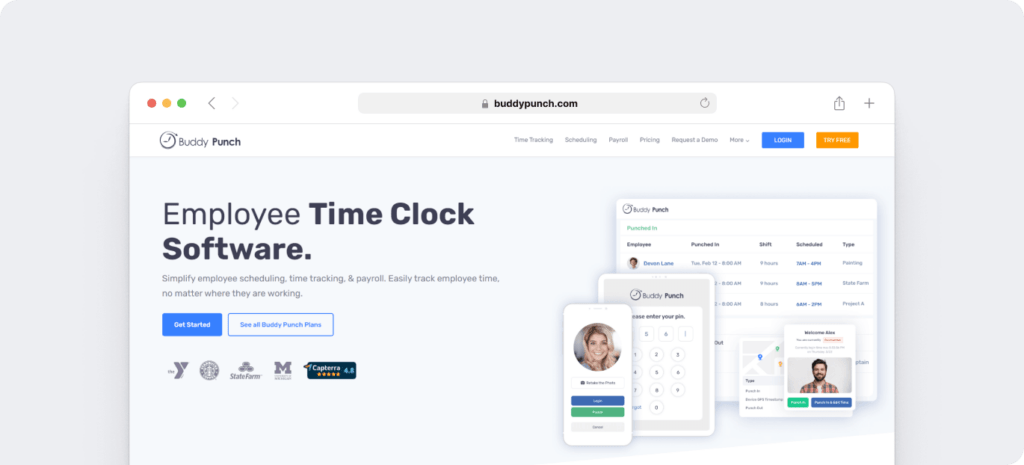
Buddy Punch uses geofencing and GPS tracking to monitor employees in the field and at remote locations. The platform is designed to keep staff accountable as they travel to job sites.
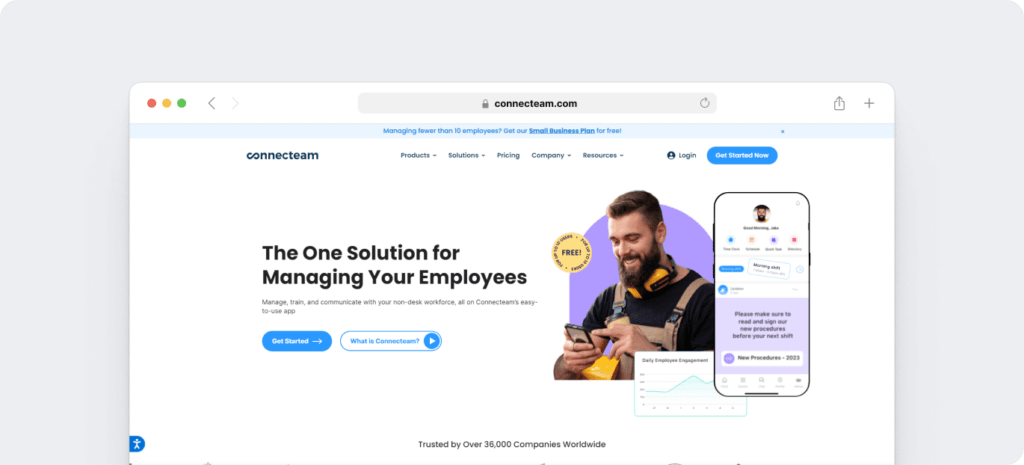
Connecteam uses GPS tracking to monitor employee locations during their shifts. The app also cross-checks logged work time with employee schedules to simplify timesheets.
Things to consider as you decide if/how you want to monitor your employees
For employers, employee-monitoring technology has plenty of advantages. However, before you implement a tracking tool, it’s also essential to consider some potential drawbacks of employee monitoring from the perspective of your team and your organization.
Ethical considerations
The most common ethical concerns center on privacy and transparency. If your team doesn’t know you’re tracking their activity or monitoring devices, they’re likely to have privacy concerns.
To address these valid concerns, be transparent about the tracking tools and methods you use for employees. Tell your team what you’re tracking—from attendance to apps and websites to idle time—so they can take steps to do their best work.
When choosing a monitoring solution, opt for one that prioritizes transparency and employee privacy. Tools like Time Doctor are more employee-friendly; they allow users to turn the tracking on and off and blur sensitive information from screenshots.
An employee-friendly tracking tool can also help team members hold themselves accountable. It can help them find ways to be more productive, which can benefit your company’s bottom line and improve employee performance.
Legal considerations
Deciding to use employee monitoring software isn’t something you should do on a whim. It’s crucial to understand the laws in your region and the legal requirements for the type of activity you plan to track—such as phone calls or emails.
For example, the Electronic Communications Privacy Act of 1986 outlines rules and regulations for monitoring certain types of employee activity in the United States. In the European Union, employers typically have to get consent from employees before tracking communications. Regional and local laws may vary as well.
If your team manages sensitive information, ensure the tool you choose has appropriate settings for security and data breaches. For example, you may need a tool that guarantees compliance with the Health Insurance Portability and Accountability Act (HIPAA) or General Data Protection Regulation (GDPR).
3 key factors for successfully implementing employee monitoring in your company
When you invest resources in a workplace monitoring program, you want to make sure it’s successful from the start. Use the 3 factors below as a guide for implementing your tracking tool of choice.
Be transparent
Are you thinking about tracking your team’s activity without informing them first? Instead of implementing a covert workplace surveillance program, be upfront about your plans and the tools you intend to use. Consider the following guidelines:
- Tell employees when you’ll track their activity. Will monitoring automatically start at the beginning of their shift? Or will employees be able to turn on tracking manually?
- Inform employees about the types of activity you’ll track. Will you monitor keyboard and mouse activity or use keystroke logging? Should employees expect screenshots, screen recordings, or video surveillance?
- Share how you’ll use the data you collect. Will you use the tracking data to rate employee performance? Should employees expect the data to affect their reviews or promotions?
Focus on performance metrics
The goal of employee monitoring should never be on micromanaging remote workers or focusing solely on employee time. Both these approaches can cause wasted time and reduced employee engagement, and neither is good for business.
Instead, use monitoring tools to measure your team’s output and the quality of their work. After all, high-quality work is a much greater business benefit than hours of low-quality output.
Tools like Time Doctor automatically track each employee’s percentage of productive time, which can help you measure engagement. This platform can also highlight your most productive teams and employees, which can be helpful for rewarding top performers.
Provide feedback and support
Rewarding high performers and providing positive feedback are great starting points. But it’s also helpful to use monitoring tools to offer constructive criticism and support.
Monitoring tools like Time Doctor can highlight your team’s lowest employee productivity levels. You can use this data to identify which team members are struggling and work with them to improve workflows or redistribute projects.
You can also use tools like Time Doctor to spot employees with work-life balance issues. You can support them by providing time off or adjusting their schedules before they reach burnout or seriously consider quitting.
Curious to see how employee monitoring (the right way) can help your team be more productive?
When you prioritize privacy, transparency, and constructive feedback, employee monitoring benefits both employers and team members. Ready to see how an employee monitoring solution works for your team? Start your free trial of Time Doctor and onboard your team today.

Liam Martin is a serial entrepreneur, co-founder of Time Doctor, Staff.com, and the Running Remote Conference, and author of the Wall Street Journal bestseller, “Running Remote.” He advocates for remote work and helps businesses optimize their remote teams.


